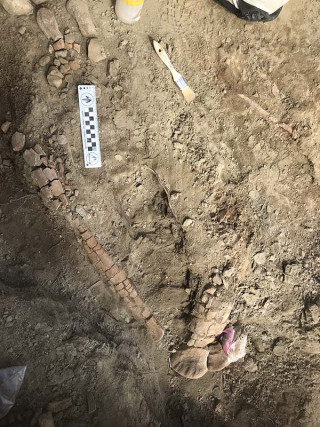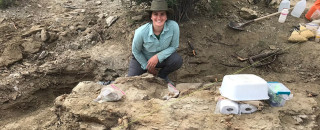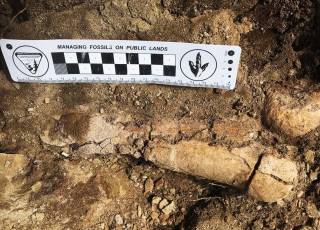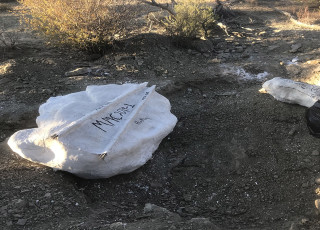Maddie’s Haddie: Sometimes Paleontology Field Work is Like the Movies
Paleontology volunteer Maddie Connolly kneeling behind the excavation of the block of rock containing her first-day find. ©NHMU
By Beth Mitchell
Field Work 101: Don’t Bring a Rolling Suitcase
There was one thought in Maddie Connolly’s mind when she walked into her first Utah Friends of Paleontology meeting in 2018.
‘All I want to do is get on digs.’
Lucky for her, NHMU Paleontology Collection Manager Carrie Leavitt-Bussian was at the meeting too.
Almost immediately, Carrie provided a path to make Maddie’s dream come true.
“Come volunteer with me in paleo collections,” Carrie offered, knowing that would ensure Maddie’s first-to-know status on upcoming NHMU field work.
Maddie started hanging out with Carrie in collections on level 3 of the museum, unpacking and cataloguing the fossil contents of boxes from a law enforcement seizure the Bureau of Land Management reposited at NHMU.
“The best part was opening boxes from the 1980s full of fossils wrapped in newsprint covered with photos of Ronald Reagan.”
Before too long, dig season was coming up, which meant that Fossil Preparator and Paleo Lab Manager Tylor Birthisel would begin interviewing volunteers keen to get out in the field.
The interview was pretty straightforward. Tylor was joined by Randy Johnson, longtime NHMU paleontology volunteer, who asked Maddie a few questions -- mostly about her ability to camp, hike in heat, hike with a heavy backpack, and her ability to go more than a week without a shower. They also made her answer to the most critical interview question of all: What is your favorite Jurassic Park movie? Beware: there is a wrong answer!
“They want you to know what you’re getting into,” said Maddie.
Field work can be exciting, but it’s hard work, and not as glamorous as it is in the movies.
“There’s a lot of hiking, a lot of whaling on really hard rocks if you’re quarrying,” Maddie explains, before joking, “They want to make sure you’re not bringing a rolling suitcase.”
Days 1 & 2: Travel and Surprise Spring Snow
On May 20, 2019, Maddie joined an NHMU caravan headed to Grand Staircase Escalante National Monument. She joined Tylor, Randy, and approximately nine other volunteers (shout-out to her first dig crew: Amber, Dane, Alan, Paul, Bob, Fred, Marcus, Lori and John!), though the group size fluctuates.
The dig site in Grand Staircase-Escalante National Monument is on BLM land, which takes a fair amount of off-roading, often navigating over steep passes through the sticky spring mud.
The first day, the crew couldn’t get the trucks through the freshly muddy, steep, and terrifying backcountry roads. Amber’s Subaru got stuck in the flowing river wash. So, they camped as far as they could get. Tylor felt pity on their souls and drove nearly an hour to retrieve and bring back pizza for morale.
The second day, they were able to make it to the official camp. “There is a campsite at the top of a large hill, along the ridge line where we set up,” said Maddie. “It’s hard to get to, but it’s beautiful.” It snowed—in May— that entire day. The team only emerged from their tents to gather snacks.
Day three finally brought nice weather, and the chance for Maddie to try her hand at prospecting with some very seasoned volunteers. It was the perfect start to what would become a once-in-a-lifetime kind of day.
Day 3: The Gift of An Untrained Eye
The plan was to grab their GPS devices and field notebooks, and drive out to a spot with known rock layer exposure and do a quick on-site training with the newbies, like Maddie.
It wasn’t always the scientific guidance that stuck with Maddie -- sometimes it was the practical tips. “Make sure to mark your truck location in the GPS,” she was told.
The team goes far enough out where misplaced vehicles are a legitimate hazard.
Randy Johnson accompanied Maddie and the other newbies on their first prospecting hike to give them additional guidance and a bit of a thrill: a horned dinosaur skull that he had been working on, which he used to provide some additional lay of the land.
“This is how to identify bones eroding from the ground; when you find something, look above it -- things usually roll downhill from the original erosion site -- things like that,” Maddie recalled.
It’s important to remember that this was all new to Maddie. “I had no actual knowledge,” she laughed, “Just a high level of interest.”
Randy offered some color tips, too, and confirmed the practice of bone-licking. “They will stick to your tongue because bones and fossils are porous...so we do do some licking.”
And then Randy just sort of said, “Off you go,” recalls Maddie, “It’s time for the ducklings to leave the nest.”
Armed with a GPS, a radio, a white board, and a clipboard, Maddie begins to wander on her own.
About 45-minutes later, Maddie saw tons of shattered orange bones in the dusty dirt. There was a concentration where the bones were coming out of the ground.
“I think because I was a newbie and I didn’t know anything, I didn’t know that orange bone on the surface gets ignored a lot, because it’s been bleached by the sun and smashed and out there for ages,” shared Maddie. “Most people would have just kept on walking.”

But she started probing the sediment with hand tools and found a long skinny bone about 2-3 inches wide and maybe 16 inches long. And then she found a knee cap, about the size of a small melon. And then that kept going into a femur.
“I radio in to Tylor and said ‘I found this sick bone,’” Maddie remembers. “And Tylor said, ‘Well how sick is it?’”
She didn’t know exactly, but she knew that Tylor would, and had a feeling it was something.
Soon, it began to downpour, and Maddie heard the call on the radio for volunteers to return to the truck. So, she began hiking her miles back to the truck.
Earlier, she had heard Tylor say that if anyone finds a bone with an identifiable feature -- like a kneecap -- to bag it up and bring it back to camp.
“Tylor is really good at identifying dinosaurs with very little to go on,” Maddie said. “So, I took some pictures and collected the melon-sized knee cap, bagged it, and grabbed the bag and headed back.”
She wasn’t sure what she had found, but she knew she had something for Tylor’s Campfire Show-and-Tell that evening.
Read part two in the series here.
Beth Mitchell is Senior Manager of External Relations at the Natural History Museum of Utah, a part of the University of Utah in Salt Lake City. Our mission is to illuminate the natural world and the place of humans within it. In addition to housing outstanding exhibits for the public, NHMU is a research museum. Learn more.



